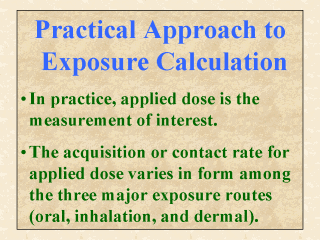| front |1 |2 |3 |4 |5 |6 |7 |8 |9 |10 |11 |12 |13 |14 |15 |16 |17 |18 |19 |20 |21 |22 |23 |24 |review |
 |
The algorithm [exposure]
= [human contact] x [environmental concentration] presented in the last
slide represents a conceptual framework, rather than a mathematical expression. In
assessing human exposure with the indirect measurement methods, the applied dose often
becomes the measurement of interest. As stated in Lecture 7, the applied dose is defined
as the amount of chemical or agent accumulated on the person's outer boundaries available
for absorption. This dose is proportional to the amount of chemical available in the
immediate environment, and to the rate of acquisition by or at the specific boundary.
Because the route-specific acquisition or contact rate is often measured per unit of time,
exposure duration is also a critical variable. For dermal exposure, the environmental concentration of interest is often not all of the amount of chemical available on the contacted surface, but the portion that is dislodgeable or that can be picked up. The acquisition rate for dermal contact is usually in terms of the rate of skin loading or of dermal transfer, thus typically measured (or reported) as per unit of time. For inhalation exposure, what become relevant are the chemical's air level in the breathing zone and the person's inhalation rate, since the product of these two components yields the amount of chemical inhaled. For ingestion and dietary intake, the acquisition rate is in terms of the amount consumed orally, typically per day. The difference between ingestion and dietary intake is that the former route involves the amount of residues available for incidental ingestion, whereas the latter deals with food contents. |